The banking industry is undergoing a transformation since the pandemic and to make sure your business process is going in sync with current trends and technologies, it’s important to have an eye on these trends as each trend has an capability to shift the banking landscape.
And no matter what industry you belong to, technology is highly disruptive. Technology can be a double-edged sword, on one side where it is transforming the business process, while on the other side it can be technically difficult for banking leaders to implement these technologies without any expert guidance.
Hence before implementing any technology trends in banking operations it’s vital to understand customer interest, and product specifications, and maintain digital trust.
Let’s deep dive into the top technology trends in the banking industry and how it can transform the present banking operations.
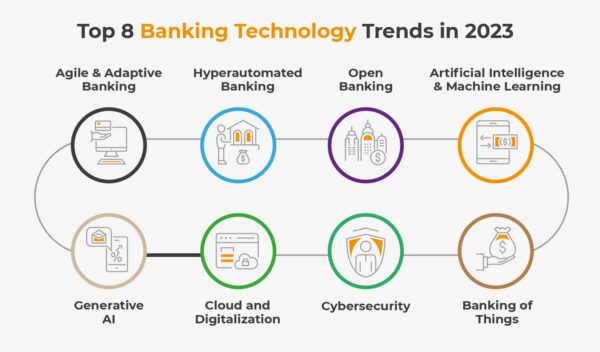
-
-
Agile & Adaptive Banking
To be adaptive and agile, the banking industry must be competitive along with being able to offer new services to its customers at great speed and efficiency. According to Gartner, around 80% of traditional banking organizations will cease to exist. Instead of the traditional banking model, agile and adaptive banking focus on a product-centric model that addresses the following concern easily-
- Identify the financial-related frauds
- Maintain the pressure connected with regulatory and compliance
- Handle financial planning and loan request approval
-
Hyperautomated Banking
RPA and hyperautomation in the banking market are expected to see a sharp rise and it is expected to reach USD 4980.65 million by 2029. In 2023 hyperautomation is now being called upon to increase the pace of banking operations. Using RPA and hyperautomation in the banking process enterprises can free up their banking staff to more repetitive and complex processes like fraud detection, and money laundering and give them the responsibility for core banking tasks. That’s not all, as per the Deloitte report, 80% of banking customers have interacted with at least one RPA tool in the last 12 months. Hence we can conclude that the RPA tool along with hyperautomation has a bright future for the banking industry
-
Open Banking
Open banking is another technology trend that delivers a myriad of opportunities for the banking industry. This technology has shown a sharp rise in its adoption due to the increased use of online platforms for transactions.
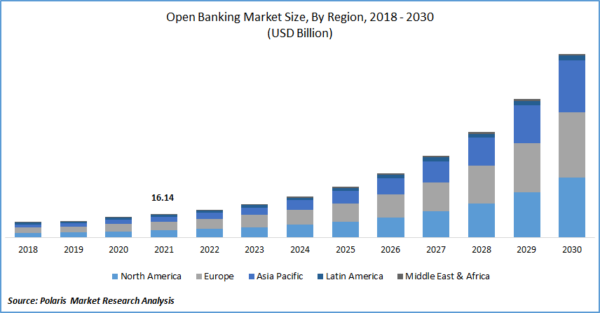 Source- Polaris Market Research
Source- Polaris Market Research
Open banking gives several benefits to banking industries, it-- Creates API infrastructure for easy data sharing
- Promotes API governance architecture for compliance and security
- Implements Data Policies to improve the efficiency of banking services provision
With easy data sharing and compliance policies, open banking promotes better customer experience and better process efficiency.
-
Artificial Intelligence and Machine Learning
AI and Machine Learning are two buzzwords and it continues to be the banking industry’s favorites since the pandemic. This is the reason, multiple banking leaders are implementing or planning to implement AI in their banking process. As per the reports around 56% of banking leaders have implemented AI for risk management.
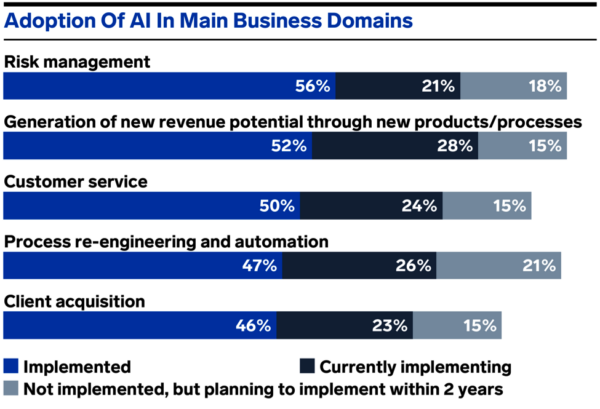 Source- Insider Intelligence
Source- Insider Intelligence
And the key driving factor behind the high growth of AI in banking industry is-- To get better operational efficiency
- Enhance personalization in service provision
- Emergence of new products and services
-
Generative AI
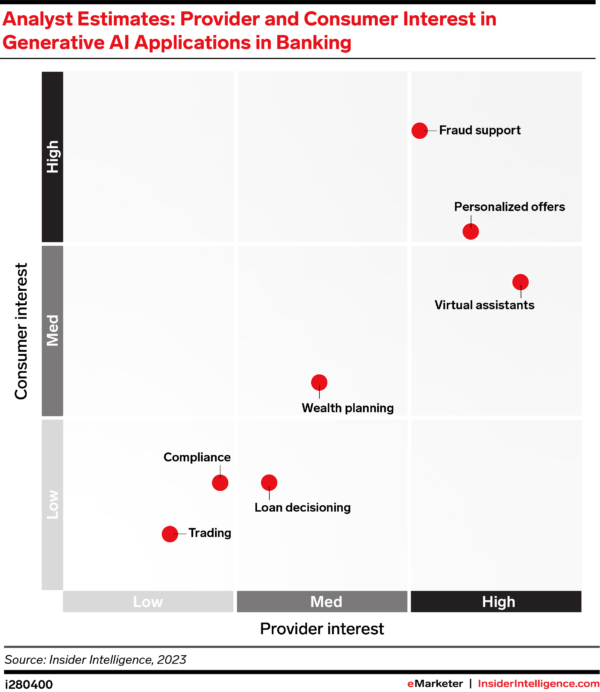 Source- https://www.insiderintelligence.com/content/state-of-banking-5-charts
Source- https://www.insiderintelligence.com/content/state-of-banking-5-charts
The best use of generative AI in banking operations could be in fraud detection, offering personalized customer service, enhancing virtual assistance capability and wealth management. With the inevitable change in technology adoption and rising customer expectations, it’s time for the banking industry to be familiar with these technology capabilities and identify where these technologies can be implemented for better process efficiency. -
Cloud and Digitalization
According to the report, the global cloud and finance market is expected to reach a value of Us$91.67 billion by 2027. Migration of banking processes into the cloud comes with multiple advantages-
- Cost reduction linked to the use of physical data centers
- Faster and better access to data with lower downtime
- Enhanced data security with transparency
All in all, bringing the banking process to the cloud is a way to make it secure, efficient, transparent, and effective. With cloud computing advancing globally, there is a lot more in the future to create better data management systems for banking services.
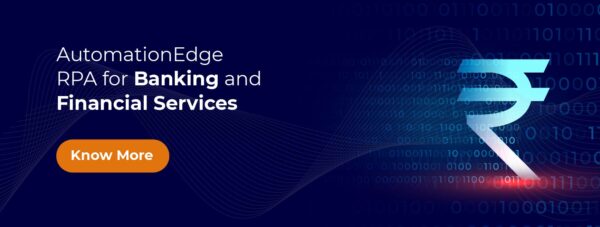
-
Cybersecurity
The IT infrastructure of the banking industry stores and processes vast amounts of confidential customer and transaction data, making it an attractive target for cybercriminals. To address this issue, startups are offering tailored cybersecurity solutions and data compliance management services for banking systems. These solutions help banks to secure their sensitive data by implementing security protocols.
The use of data encryption tools further reduces the risk of data breaches. AI-powered fraud detection is also employed to identify and prevent suspicious activities, such as identity theft and phishing scams. Additionally, banks utilize anti-hacking software to prevent unauthorized access to their networks. These features enable banks to improve their threat detection and response capabilities.
-
Banking of Things
IoT technology is increasingly being integrated into the banking industry to enhance data collection efficiency. This automation facilitates the acquisition of data, streamlines processes such as KYC and lending, and enables real-time event response.
For instance, smart automated teller machines (ATMs) equipped with IoT capabilities send notifications for low cash levels and malfunctions, ensuring timely maintenance. Additionally, IoT-enabled digital wallets are embedded in mobile phones and smartwatches to allow customers to make purchases conveniently. Furthermore, IoT devices transmit customer-specific data in real time, enabling banks to identify fraudulent activities and prevent losses.
-
From the above technology trends we can conclude that the future of banking is the tech and it will continue to disrupt the banking industry. Hence it is advisable for the banking and financial industry to take note of all these trends and take corrective measures for enhancing process efficiency.
The post Top 8 Banking Technology Trends in 2023 appeared first on AutomationEdge.
This is a companion discussion topic for the original entry at https://automationedge.com/blogs/top-8-banking-technology-trends-in-2023/